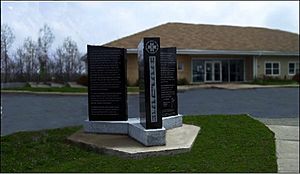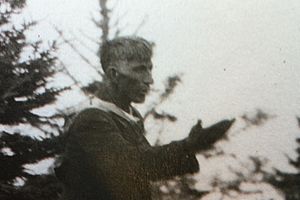Treaty of 1752 facts for kids
Quick facts for kids Treaty of 1752 |
|
|---|---|
| Canada | |

Monument to the Treaty of 1752
|
|
| For the Treaty of 1752 | |
| Location | near |
The Treaty of 1752 was an important agreement signed a long time ago, on November 22, 1752. It was made between the Mi'kmaq people from Shubenacadie, a place in Nova Scotia, and the leader of Nova Scotia at the time, called the governor. This treaty happened during a period known as Father Le Loutre's War.
The idea for the treaty came from Edward Cornwallis, who was a key figure in Nova Scotia. Later, it was officially signed by Jean-Baptiste Cope, a leader of the Mi'kmaq, and Governor Peregrine Hopson. Cornwallis was present at the signing because Cope had asked him to be there.
Contents
Understanding the Treaty of 1752
This section explains how the Treaty of 1752 has been looked at in modern times. People have gone to court to understand what the treaty means for Indigenous rights today.
Early Efforts to Uphold the Treaty
In 1928, a Mi'kmaq leader named Mr. Gabriel Sylliboy was the first to bring the Treaty of 1752 to court. He was the Mi’kmaq Grand Chief. He was accused of having animal furs, which was against a provincial law at the time.
Mr. Sylliboy argued that the 1752 treaty protected his right to have these furs. However, the judge decided that the treaty only applied to a small group of Mi’kmaq people in Shubenacadie. Since Mr. Sylliboy was from a different area, Whycocomagh, the judge said the treaty did not apply to him.

Later Court Cases and Treaty Rights
Many years later, in 1985, another person named Mr. Simon, who was from Shubenacadie, also used the Treaty of 1752 in court. The court in this case said that the treaty did protect hunting rights for people from Shubenacadie.
The court also mentioned that there wasn't enough information at that time to say if the treaty had ended because of later conflicts. However, the court did not agree that the treaty gave Indigenous people the right to hunt and fish for business purposes.
The Donald Marshall Jr. Case
In 1993, a man named Donald Marshall, Jr., from Cape Breton, was involved in a court case about fishing. He had caught eels and sold them. At first, his lawyer focused on the Treaty of 1752 to support his right to fish.
A historian named Dr. Stephen Patterson, who worked for the government, looked closely at the Treaty of 1752. He suggested that the treaty might not apply to Mi’kmaq people outside of Shubenacadie. He also said that the treaty might have ended due to later conflicts. It's important to know that Chief Cope, who signed the treaty, actually cancelled and destroyed it himself just six months after signing it.
Because of this new information, Donald Marshall, Jr.'s lawyers decided to change their approach. They started to focus on different agreements called the Halifax Treaties of 1760-61 instead of the Treaty of 1752.

